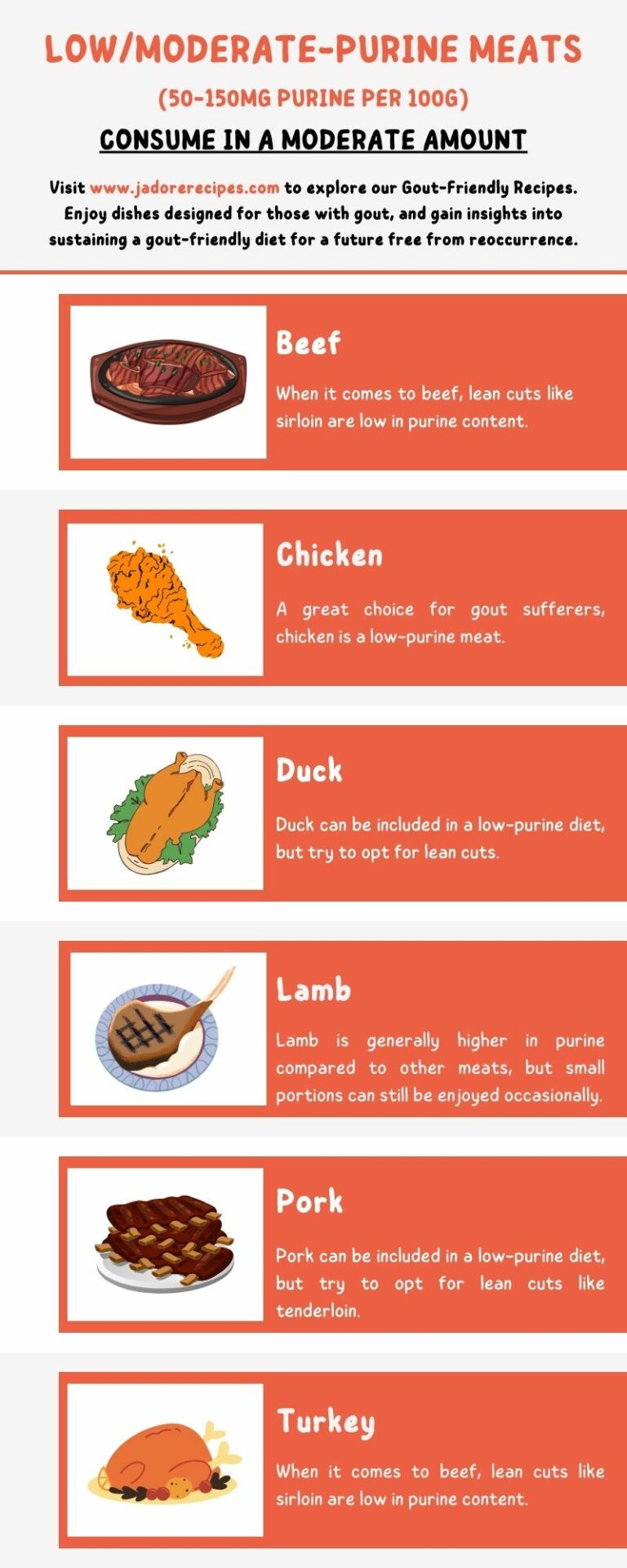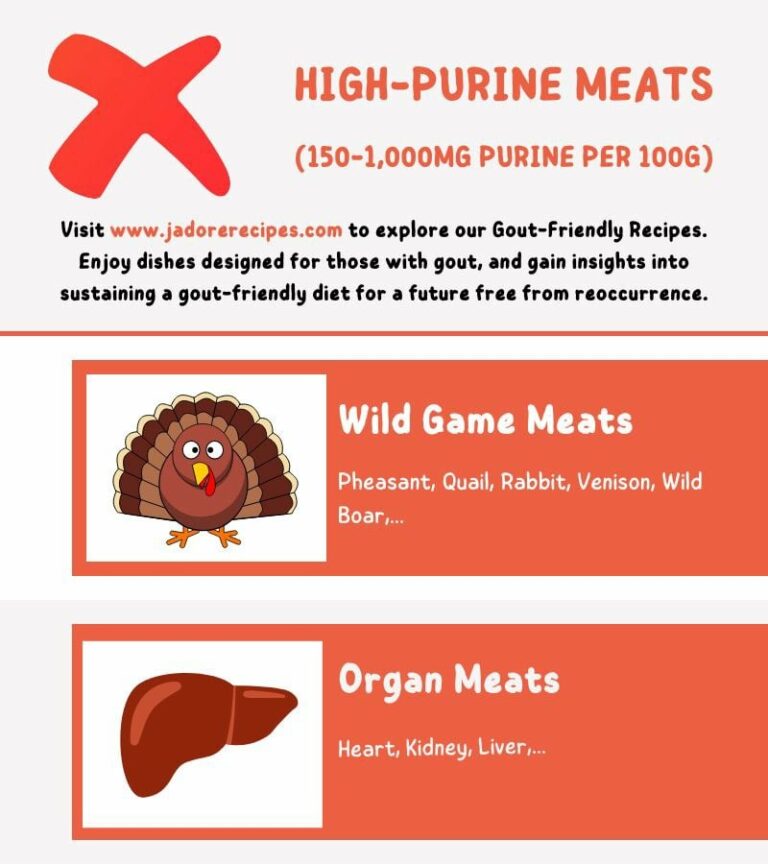Gout is a type of arthritis that occurs when uric acid crystals accumulate in the joints, leading to severe pain and disability. Managing gout requires a combination of medication, lifestyle adjustments, and careful food choices. This detailed guide focuses on the best types of meat to consume if you have gout. We will discuss lean sources of protein and nutrient-dense options that can help alleviate your symptoms and promote your overall health.
Table of Contents
- Can you still enjoy meat if you have gout?
- Benefits of Eating the Right Meats for Gout
- Top Choices of meat for individuals with Gout
- Other Food Options for Providing Proteins
- Practical Tips for a Gout-Friendly Diet
- Finding Balance in Your Diet
- Frequently Asked Questions
- Conclusion
1. Can you still enjoy meat if you have gout?
Many gout sufferers are often concerned about whether or not they can still enjoy meat if they have gout. The good news is that, with careful selection and portion control, meat can still be a part of a gout-friendly diet. It is crucial to choose suitable types of meat, including lean beef and pork cuts, and monitor intake to manage gout symptoms effectively. By making mindful choices and finding the right balance, gout sufferers can include meat in their diet without exacerbating their symptoms.
2. Benefits of Eating the Right Meats for Gout
Choosing the right kind of meat can have several benefits for people suffering from gout. It is crucial to select the right type of meat to maintain a gout-friendly diet. By incorporating meats that are suitable for people with gout, individuals can ensure they get the essential nutrients they need while managing their symptoms. The appropriate meats offer a balanced protein intake, which is vital for overall health and gout management. Gout sufferers can maintain a well-rounded diet that supports their overall health and well-being by selecting the right kind of meat.
3. Top choices of meat for individuals with Gout.
When choosing meats for gout, there are specific options that are more gout-friendly than others. Let’s explore the best meat options for gout, divided into two categories: low-purine meats and moderate-purine meats.
Low-Purine Meats
Chicken, turkey, and duck are lower in purine content, making them excellent options for gout sufferers. These white meats, including white bread, are lean, protein-rich, and can be easily incorporated into gout-friendly meals. Lean cuts of beef and pork, with a recommended daily intake of approximately 4 to 6 ounces, can also be suitable for gout management. By opting for white meats and lean cuts, gout sufferers can enjoy meat while minimizing the risk of flare-ups. Additionally, it is important to limit the intake of types of seafood to one serving per day as they still contain purines.
Moderate-Purine Meats
While meats higher in purine content should be consumed in moderation, gout sufferers can still enjoy meats with a moderate purine content, such as lamb and veal. Including meats with average purine levels adds variety to the diet of gout sufferers, allowing for a more enjoyable eating experience. Making informed choices about meats with moderate purine levels is essential to manage gout symptoms effectively.

4. Other Food Options for Providing Proteins
There are several alternative protein sources to consider for people with gout who cannot consume meats high in purines. These include low-purine meats like chicken and turkey, low-purine fish, plant-based proteins like tofu and tempeh, and dairy products like milk, cheese, and yogurt.
5. Practical Tips for a Gout-Friendly Diet
When it comes to managing gout, it is not just about the meats you eat but also about the overall diet and healthy habits you adopt. Here are some practical tips to incorporate into your gout-friendly diet:
Portion control and healthy cooking methods
Individuals with gout can regulate uric acid levels by practicing portion control and being mindful of uric acid concentration. Eating lean protein sources and limiting meat intake is advisable while utilizing healthy cooking methods such as grilling, broiling, or steaming. These methods reduce unhealthy fats while maximizing health benefits. Incorporating a vitamin C supplement into one’s diet can also aid in lowering uric acid levels and improving symptoms associated with gout. By implementing these habits, individuals with gout can enjoy their preferred meats in a healthy manner, promoting overall health and well-being.
Incorporating physical activity
Regular exercise, such as walking, swimming, cycling, and aerobics, is crucial for managing uric acid levels and promoting overall health for individuals with gout. These low-impact exercises can support gout management and help maintain a healthy weight, essential for reducing the risk of gout attacks and managing symptoms, including weight loss. Studies have shown that incorporating physical activity into daily routines can also lower uric acid levels and decrease the frequency of gout attacks, making it a vital aspect of gout management. This is because physical activity helps the body to efficiently remove excess uric acid, preventing it from accumulating and crystallizing in the joints.
6. Finding Balance in Your Diet
Striking a balance between meat intake and other foods is vital for gout management. Achieving dietary balance is essential for gout sufferers to minimize flare-ups and maintain overall health. By incorporating heart-healthy options, such as vegetables, whole grains, and healthy fats, into their diet, gout sufferers can create a well-rounded and supportive meal plan for managing their condition. This includes following diets known to support heart health, such as the DASH and Mediterranean diets, which are effective in managing gout symptoms and improving overall well-being. Gout sufferers can further enhance the benefits of this eating pattern by adding lean protein from meat, poultry, fish, nuts, and legumes to the DASH diet. This can help gout sufferers maintain stable blood pressure levels and reduce inflammation, which is crucial for managing and stabilizing blood sugar levels.
7. Frequently Asked Questions
What proteins can I eat if I have gout?
When choosing meats for gout, it is important to consider the purine content of the meat. Here are the best types of meat to eat if you suffer from gout:
- Lean meats such as chicken and turkey are generally safe for those with gout. These white meats have lower purine content, making them suitable options for gout sufferers.
- Fish high in omega-3 fatty acids, like salmon and tuna, also benefit gout sufferers. These types of fish can help reduce inflammation associated with gout.
- Red meat should be limited or avoided, but choose lean cuts like sirloin or tenderloin if consumed. It is best to consult a healthcare professional to determine the appropriate amount of red meat for your specific condition.
- Processed meats like hot dogs and deli meats should be avoided due to their higher purine content.
Is it safe to eat red meat if you have gout?
Red meat has higher purine content, which can increase uric acid levels and worsen gout symptoms. While it is not recommended to consume large amounts of red meat if you have gout, lean cuts of red meat, such as sirloin or tenderloin, can be included in moderation to help lower uric acid levels. However, it is best to consult a healthcare professional or a registered dietitian to create a personalized meal plan for managing gout. Additionally, specific foods such as organ and glandular meats should be avoided due to their high purine levels. Dairy products, such as low-fat or non-fat options, have been shown to lower uric acid levels and can be incorporated into a gout-friendly diet. It is important to choose low-fat or non-fat options to avoid excess saturated fat intake, which can also worsen gout symptoms. If you have gout, monitoring your uric acid concentration and limiting foods that can increase it, such as red meat and plant foods, including plenty of vegetables, is important.
Can consuming organic or grass-fed meats help alleviate symptoms of gout?
Consuming organic or grass-fed meats may not directly alleviate gout symptoms, but they can be healthier for overall well-being. These meats are generally lower in saturated fat and higher in beneficial nutrients, which can contribute to better general health management for those with gout.
Are there any meats that should be avoided if you have gout?
Meats that are higher in purine content, such as organ meats like liver and kidneys, as well as game meats and fatty cuts of beef or pork, should be avoided if you have gout. These types of meats can increase the risk of recurring gout attacks.

Can a balanced diet help alleviate symptoms of gout?
Yes, a balanced diet can help alleviate symptoms of gout. By incorporating lean meats, such as chicken and fish, and caffeinated coffee into your diet, gout sufferers can obtain the nutrients for gout management. Avoiding high-purine foods, such as red meat and organ meats, as well as sugary drinks like fruit juice, can also help manage gout symptoms, including gout flare. It is best to consult a healthcare professional or a registered dietitian to develop a personalized diet plan for managing gout, including gout flare.
8. Conclusion
Yes, a balanced diet can help alleviate symptoms of gout. By incorporating lean meats, such as chicken and fish, and caffeinated coffee into your diet, gout sufferers can obtain the nutrients for gout management. Avoiding high-purine foods, such as red meat and organ meats, as well as sugary drinks like fruit juice, can also help manage gout symptoms, including gout flare. It is best to consult a healthcare professional or a registered dietitian to develop a personalized diet plan for managing gout, including gout flare.